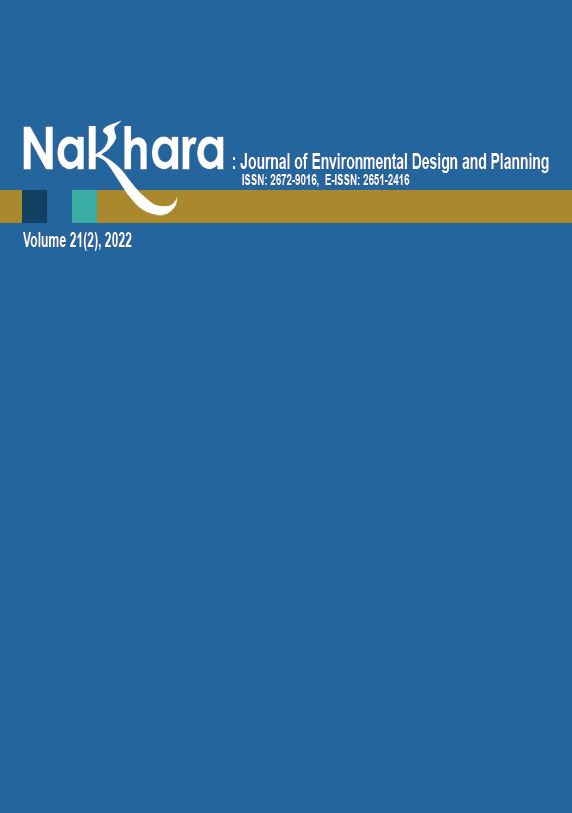Characteristic Factors Influencing the Thai-Style Public Space Utilization: Case Study of Sanam Na Mueang Public Park in Nakhon Si Thammarat Old Town, Thailand
Main Article Content
Abstract
This research aims to identify the characteristic factors influencing the Thai-style public space utilization with the combination of variables of good public space characteristics following the occidental and Thai theories from the perspective of actual users in order to create new components or factors influencing the Thai-style public space utilization. Sanam Na Mueang Public Park, located in Nakhon Si Thammarat Old Town, was specified as the study area. Principal component analysis (PCA) was employed to classify 30 variables influencing the success of public space utilization; data was collected from questionnaire responses provided by 320 people. The results indicate that the new characteristic factors influencing Thai-style public space utilization consist of contextual connection and space identity, landscape elements, and aesthetics of public space utilization. These results reflect that both contextual connection and space identity, and landscape elements are consistent with occidental theories that prioritize physical characteristics and promote the access and facilitation, while the aesthetics of public space utilization, in contrast to occidental theories, prioritize the aesthetics of utilization and visibility to the surrounding people and activities.
Article Details

This work is licensed under a Creative Commons Attribution-NonCommercial-NoDerivatives 4.0 International License.
References
Asmawi, M. Z., Mohit, M. A., Noor, N. M., & Paiman, T. (2018). Factor analysis on hedonic pricing model on open space affecting the housing price in Melaka and Seremban. Journal of the Malaysian Institute of Planners, 16(2), 119-130. https://doi.org/10.21837/pm.v16i6.467
Atiphot, K. (2002, n.d.). The Space of Thai Society [Lecture note]. Retrieved from Faculty of Architecture Chulalongkorn University.
Comrey, A. L., & Lee, H. B. (1992). A first course in factor analysis. Psychology Press.
Field, A. P. (2009). Discovering Statistics Using SPSS: (and Sex and Drugs and Rock “n” Roll) (3rd ed.). Sage.
Gehl, J. (1987). Life Between buildings. Van Nostrand Reinhold.
Gehl, J., & Birgitte, S. (2013). How to study public life. Island Press.
Hair, J.F., Black, W.C., Babin, B.J., Anderson, R.E. & Tatham, R.L. (2006). Multivariate data analysis (6th ed.). Prentice Hall.
Hillier, B. (1989). The architecture of the urban object. Ekistics, 56(334/335), 5-21.
Hillier, B. (1996). Cities as movement economies. Urban Design International, 1, 41-60. https://doi.org/10.1057/udi.1996.5
Hillier, B. (1999). Centrality as a process: Accounting for attraction inequalities in deformed grids. Urban Design International, 4(3), 107-127.
Hillier, B., & Hanson, J. (1984). The social logic of space. Cambridge University Press.
Hillier, B., Hanson, J., Penn, A., & Grajewski, T. (1993). Natural movement: Or, configuration and attraction in urban pedestrian movement. Environment and Planning B: Planning and Design, 20, 29-66.
Hillier, B., & Sahbaz, O. (2008). An evidence based approach to crime and urban design. Or, can we have vitality, sustainability and security all at once?. Revista INVI, 23(64), 1-28
Jacobs, J. (1992). The Death and Life of Great American Cities (Vintage Books ed.). A Division of Random House, Inc
Jolliffe, I. T. (2002). Principal component analysis for special types of data. In P. Bühlmann, P. Diggle, U. Gather & S. Zeger (Eds.), Springer Series in Statistics (pp. 338-372). Springer.
Kongphunphin, C., & Iamtrakul, P. (2018). The Transition of Roles of Public Spaces in Thailand. Journal of the Faculty of Architecture King Mongkut's Institute of Technology Ladkrabang, 26(1), 30-40.
Kongphunphin, C., Iamtrakul, P., & Srivanit, M. (2018). The attitude in urban planning of Thai urban public space: A case study of Bangkok metropolitan area, Thailand. International Journal of Building, Urban, Interior and Landscape Technology (BUILT), 2018(12), 61-76.
Lennard, C., & Lennard, H. L. (1995). Livable cities observed. Gondolier Press.
Marcus, C. C., & Francis, C. (1998). People places: Design guidlines for urban open space. Van Nostrand Reinhold.
Musigakama, P. (2019). The commodification of public spaces on Khao San road. Nakhara: Journal of Environmental Design and Planning, 17, 81-96. https://doi.org/10.54028/NJ2019178196
Nathiwutthikun, K. (2008). The logic of multi-use of public open spaces in Chiang Mai city. Nakhara: Journal of Environmental Design and Planning, 4, 45-68.
Newman, O. (1972). Defensible space: Crime prevention through urban design. Macmillan.
O' Connor, A. R. (1983). A theory of Indigenous southeast Asian urbanism. Institute of Southeast Asian Studies.
Oranratmanee, R. (2014). The Ideas of Public Space: Between West and East. In S. Suwatcharapinun (Ed.), Towards Architectural Theories Public Space and Social Space (pp. 31-53). Chaingmai: Chiang Mai University Press.
Office of the National Economic and Social Development Council. (2016). The twelfth national economic and social development plan (2017-2021). https://www.nesdc.go.th/ewt_news.php?nid=6420&filename=develop_issue
Paksukcharern, K. (2008, 2 August). Energy-saving shortcut alleys: small public spaces - social spaces of Thai communities [Paper presentation]. The 2008 Urban and Regional Planning Sysposium on: energy-saving, Faculty of Architecture Chulalongkorn University.
Rakpan, K., & Oranratmanee, R. (2014). The continuity of Kad Luang market district in the dynamics of change in Chiang Mai city. Journal of Mekong Societies, 10(2), 197-214.
Sanoff, H., & Dickerson, J. (1971). Mapping children's behavior in a residential setting. Journal of Architectural Education (1947-1974), 25(4), 98-103.
Şatir, S., & Korkmaz, E. (2005). Urban open spaces with examples & the classification of urban furniture. A|Z ITU Journal of the Faculty of Architecture, 2(1/2), 130-14.
Tabachnick, B. G., & Fidell, L. S. (2001). Using multivariate statistics. Allyn and Bacon.
Tantimala, C. (2017). Public spheres and production of space: The meaning of social relationships. Journal of Library and Information Science Srinakharinwirot University, 10(1), 92-103.
Thinnakorn, W. (2021). The urban image conservation and development of Nakhon Si Thammarat’s old town community in Thailand. Nakhara: Journal of Environmental Design and Planning, 20(3), 1-19. https://doi.org/10.54028/NJ202120120
Whyte, W. H. (1980). The social life of small urban space. The ConservationFoundation Washington.
Wilson, J. Q., & Kelling, G. L. (2017). The police and neighborhood safety Broken Windows. In J. T. Walker (Ed.), Social, Ecological and Environmental Theories of Crime (pp. 1-10). Routledge.
Wirth, L. (1938). Urbanism as a way of life. The American Journal of Sociology, 44(1), 1-24.
Zucker, P. (1959). Town and square: From the agora to the village green. Columbia University Press.

